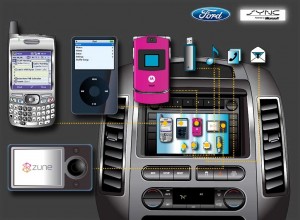
A new lawsuit claims Ford has infringed on a number of patents with its Sync system and other technologies.
Patent trolls are after the Ford Motor Co. Eagle Harbor and another firm, MediusTech LLC, of Bainbridge Island, Washington, have filed a lawsuit in federal court in Tacoma, Washington, alleging the Detroit maker infringed on Eagle Harbor’s patents.
The suit claims Ford is using several automotive technologies, notably including the Sync infotainment system, Active Park assist, blind-spot identification with cross traffic alert, MyKey and stability control, without authorization.
The lawsuit also claims Ford has used and continues to use the companies’ patented technology in multiple vehicle systems.
“Our representatives began meeting with Ford in 2002 to discuss and disclose our patented automotive systems technology and its applicability for use in Ford vehicles,” said Jeffrey Harmes, general counsel for Eagle Harbor Holdings, LLC.
“These meetings continued until 2008, when Ford stopped communications with us. In early 2009 we informed Ford that its automotive audio systems infringed on our patents. In March 2010, we again informed Ford that its automotive electronics systems, including Ford SYNC, infringed on our patents. Unfortunately, despite our many efforts to communicate with Ford and resolve these issues, Ford continues to refuse to license its use of our patented technology. Ford is ignoring our patent rights and continues to use, without permission or license, Eagle Harbor’s technology,” Harmes said.
Dan Preston, Eagle Harbor Holdings, LLC’s chairman and managing member is an inventor of most of the patents asserted in the lawsuit. His son, Joe Preston, is the company’s chief technology officer. Together, they were co-founders of Airbiquity, whose technologies were deployed in the General Motors OnStar system. Dan Preston is also president and CEO of MediusTech.
Ford has never hid the fact that it has developed various technologies with help from suppliers ranging from Microsoft for Sync to Continental, which has developed several of the safety systems referred to in the new lawsuit.
Harmes said his clients’ business plan has always been to develop technologies from their inception to their commercialization, and to make them available to a broad range of consumers. It is important that their continued ability to do that, and the ability of other inventors to do the same thing, not be thwarted by the unlawful use of their ideas and patented technology,” he said.
Ford has not yet responded to the lawsuit but it is expected to resist the claims. Some industry insiders downplayed the lawsuit, while others warn it could be a problem for the maker considering the way the courts sometimes broadly assert patent claims.
The growth of consumer electronics has led to the emergence of so-called “patent trolls.” Wikipedia defines them as “a person or company that enforces its patents against one or more alleged infringers in a manner considered (by the party using the term) unduly aggressive or opportunistic, often with no intention to manufacture or market the patented invention.”
In some cases, the courts have tossed such lawsuits out for being overly vague, but others have been upheld and result in huge settlements, as the makers of the Blackberry phone and e-mail system discovered when they were sued a few years back.
Ford has had a history of resisting broad patent claims, founder Henry Ford successfully battling George B. Selden, who claimed to have patented the automobile itself in 1895. Though Selden never went into production he was able to squeeze royalty payments out of most automakers of the era – until Ford defeated Selden during an appeals court hearing in January 1911.
On the other hand, Ford lost a long and costly patent infringement case in 1990, paying inventor Robert Kearns $10.1 million to settle claims that the maker had violated patents for the intermittent wiper. Chrysler also lost to Kearns while other makers agreed to settle out of court. The inventor reportedly came up with the idea in 1963, but after failing to win business from the auto industry, most makers began using the Kearns concept, beginning in 1969.
Paul A. Eisenstein contributed to this report.

I think that you are missing the point of patent trolls. Actually it is not the Kearns patents that are germane to the issue. It is more like the Krippelz patents that are germaine. Krippelz went to Ford and offered to sell the patent for a small fee and Ford decided against purchasing the patent and then a few years later made a device that used the patent. It cost them almost 80 million dollars…
Fair point, though I think that many people lump all patent infringement claims together, and many dismissed Kearns, at least initially. I referred to him specifically because he was an example of a case where there was a legitimate gripe about patent theft. The Krippelz case goes the other way.
Paul A. Eisenstein
Publisher, TheDetroitBureau.com